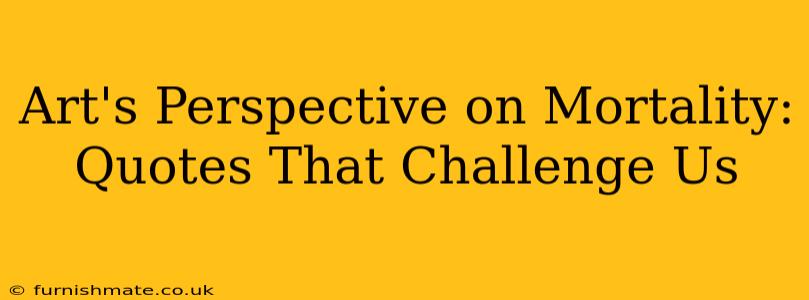Art, in all its forms, has grappled with mortality since its inception. From ancient cave paintings depicting the hunt and the cycle of life and death to modern-day installations exploring existential dread, artists have consistently used their craft to explore, interpret, and challenge our understanding of mortality. This isn't merely about depicting death; it's about exploring the human experience in the face of its inevitable end, prompting introspection and offering profound insights into what it means to be alive. This article delves into powerful quotes from artists and their works that confront our mortality, prompting us to re-evaluate our own perspectives.
Why Art Explores Mortality?
Art's exploration of mortality stems from a fundamental human need: to make sense of our existence and confront our own finitude. The ephemeral nature of life, the constant reminder of our own mortality, is a driving force behind many artistic expressions. Art provides a safe space to process these complex emotions, allowing us to confront our fears, accept our limitations, and ultimately, celebrate the beauty of life in the face of death. It offers a platform for catharsis, reflection, and a deeper understanding of the human condition.
Powerful Quotes on Mortality from Artistic Masters
Throughout history, artists have captured the essence of mortality through words as well as imagery. The following quotes offer a glimpse into their profound reflections:
"The purpose of life, after all, is to live it, to taste experience to the utmost, to reach out eagerly and without fear for newer and richer experience." – Eleanor Roosevelt
While not strictly an artist in the traditional sense, Eleanor Roosevelt's words resonate deeply with the artistic spirit. Her quote emphasizes the importance of embracing life fully, knowing its limitations. This aligns perfectly with the artistic drive to capture the fleeting moments of existence and celebrate their beauty before they fade.
"We do not remember days, we remember moments." – Cesare Pavese
This quote from the Italian writer and literary critic highlights the power of experiencing life intensely. The artistic endeavor, in its meticulous attention to detail and emotional depth, often seeks to capture and preserve precisely these significant moments, transforming them into lasting expressions that transcend mortality.
"Art enables us to find ourselves and lose ourselves at the same time." – Thomas Merton
This quote speaks to the dual nature of art's engagement with mortality. It allows for self-discovery through the act of creation, yet simultaneously connects us to something larger than ourselves, reminding us of our place within the larger scheme of existence.
How Art Helps Us Confront Mortality
Art’s impact on our understanding of mortality goes beyond simply depicting death; it acts as a powerful tool for processing our feelings and experiences. Several ways art aids us in confronting our mortality include:
- Providing a safe space for emotional expression: Art provides a non-judgemental space to explore complex emotions surrounding death and loss, allowing for catharsis and healing.
- Encouraging introspection and self-reflection: Engaging with art that explores mortality prompts introspection about our own lives, values, and legacy.
- Offering a sense of connection and community: Shared experiences with art can create a sense of community among those grappling with similar thoughts and emotions about mortality.
- Celebrating the beauty of life: By confronting death, art underscores the preciousness of life, reminding us to live fully and appreciate each moment.
Frequently Asked Questions
What are some common artistic themes related to mortality?
Common themes include vanitas (still lifes depicting the transience of life), memento mori (artistic reminders of death), depictions of the afterlife, and explorations of grief and loss. These themes manifest in various art forms, from painting and sculpture to literature, music, and performance art.
How does art differ from other methods of confronting mortality, such as philosophy or religion?
While philosophy and religion offer intellectual and spiritual frameworks for understanding mortality, art offers a more visceral and emotional approach. Art bypasses abstract concepts and engages directly with our senses and emotions, providing a more personal and relatable experience.
Can art truly help us overcome our fear of death?
Art may not entirely eliminate the fear of death, but it can help us manage and process those feelings. By offering a safe space for exploration and expression, art provides tools for confronting our fears, accepting our limitations, and ultimately, finding meaning in life despite its inevitable end.
What are some examples of art that powerfully portray mortality?
Numerous works across history powerfully portray mortality. Think of the chilling memento mori paintings of the Dutch Golden Age, the poignant sculptures of funerary art from ancient civilizations, or the emotionally charged contemporary installations exploring themes of loss and memory. The specific examples are numerous and depend greatly on individual interpretation and response.
In conclusion, art offers a unique and powerful lens through which to examine mortality. By exploring themes of death, loss, and the fleeting nature of existence, artists provide us with tools to process our emotions, find meaning in life, and ultimately, come to terms with our own mortality. The quotes and insights presented here only scratch the surface of this rich and complex relationship between art and mortality, prompting continued reflection and engagement.

